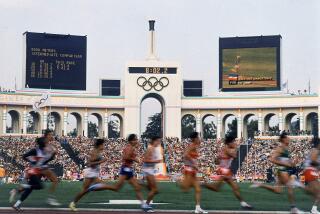Book review: âUnbrokenâ by Laura Hillenbrand
Unbroken
A World War II Story of Survival, Resilience, and Redemption
Laura Hillenbrand
Random House: 480 pp., $27
As I read Laura Hillenbrandâs stirring and triumphant account of the harrowing experiences of American Olympic runner and World War II POW Louis Zamperini, I thought of the double load that the research and writing of âUnbrokenâ had put on its author.
Hillenbrand is herself a steely example of triumph over more than 23 years of debilitating illness. She won a National Magazine Award for âA Sudden Illness,â a 2003 article in the New Yorker which describes her battle with chronic fatigue syndrome. The author of âSeabiscuitâ (a bestseller-turned-Oscar-nominated 2003 film) and âUnbrokenâ has transmuted her own life struggle into two irresistible stories about athletes gifted with preternatural speed who overcome severe handicaps to achieve victory. Talk about transcending obstacles.
Like Seabiscuit, the legendary thoroughbred champion, Louie Zamperiniâs early years of athletic success â shattering the national high school record for a mile in 1934 and running a 56-second last lap in the 5,000-meter race at the 1936 Berlin Olympics at age 19 â brought him to national attention during the struggling Depression years.
Hillenbrand tells his story as a nearly continuous flow of suspense. She opens with a gripping two-page glimpse of Army Air Forces bombardier Zamperini in mortal danger, lying on a raft in the Pacific on June 23, 1943. He and three other survivors of a plane crash are gaunt after 27 days at sea: âSharks glided in lazy loops around them, dragging their backs along the rafts, waiting.â Spotting a plane, Zamperini fires off two flares only to discover that it is a Japanese bomber. Strafing begins.
After that powerful scene, âUnbrokenâ gallops along at full speed for another 330 pages, the first four sections of the book. Hillenbrand gives us the 12-year-old Zamperini, the son of Italian immigrants, spotting the German dirigible Graf Zeppelin hovering over his backyard in Torrance like a ghostly image of his future.
Looping back, Hillenbrand shows how Zamperini was untamable from birth. âFrom earliest childhood, he fought every curb on his freedom,â she writes. âEvery rule set before him, every thwarted desire, was an irresistible invitation to defiance.â By high school, his energy harnessed by his older brotherâs suggestion that he try track, he had become one of the fastest runners on Earth. He was a juggernaut on USCâs track team, smashing the NCAA record in 1938 while running with a cracked rib and puncture wounds to both legs and one foot. He bested world-class miler Glenn Cunningham twice in 1940 and seemed destined to be the first to break the four-minute-mile barrier. The only runner who could beat him was Seabiscuit, his coach said. Then the 1940 Olympics were canceled, and Zamperini went to war.
Zamperiniâs childhood âshaped who he would be in manhood,â Hillenbrand writes. âConfident that he was clever, resourceful, and bold enough to escape any predicament, he was almost incapable of discouragement. When history carried him into war, this resilient optimism would define him.â
As a bombardier, Zamperini was confined mostly to the B-24, nicknamed the âFlying Coffin,â for its frequent mechanical failures. From his first bombing run, during a Dec. 23, 1942, American raid on the Japanese base on Wake Island , to his crash landing in the Pacific while on a rescue mission in 1943, his flying time was measured only in months.
Zamperini would spend 47 days at sea before being captured by the Japanese. From then until the warâs end in 1945, he was engaged in a hair-raising struggle to survive. He was imprisoned at such infamous prisoner-of-war camps as the one on Kwajalein Atoll (nicknamed âExecution Islandâ) and the secret interrogation center Ofuna. Murderously sadistic guards, starvation rations and bloody dysentery all whittled away at his body and soul. Finally, he wound up at Naoetsu POW camp northwest of Tokyo, where a psychotic prison official known as âThe Birdâ made it his mission to break Zamperini down.
Hillenbrandâs vivid accounts of battles, technological advances such as the top-secret Norden bombsight, explanations of Japanese policy toward POWs (including a âkill-allâ order at warâs end) as well as her footnotes and acknowledgments detailing her research are all worthy of careful reading. But it is the tension of Zamperiniâs fight to live in barbaric conditions that makes âUnbrokenâ so disturbing and thrilling.
A novelist might have ended âUnbrokenâ with the warâs end. Hillenbrand adds a fifth act, showing how echoes of Zamperiniâs captivity shaped the decades after his release and how a meeting with Billy Graham helped him to claim a lasting victory over his deep emotional wounds.
Ciabattari is a regular contributor to NPR.org and the Daily Beast, among other publications. The author of âStealing the Fire,â she serves as president of the National Book Critics Circle.
More to Read
The biggest entertainment stories
Get our big stories about Hollywood, film, television, music, arts, culture and more right in your inbox as soon as they publish.
You may occasionally receive promotional content from the Los Angeles Times.










